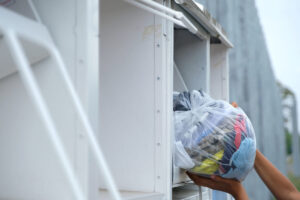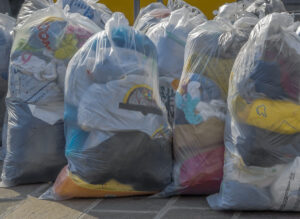News & Stories
Safety Practices for Using Donation Boxes
Jan 20, 2025
How to Use Our Clothing Donation Boxes
This blog explores the basics of safety and cleanliness when using donation boxes in Edmonton and the Greater Edmonton area. Find out how to properly get your items ready, give them away, and make sure your donations help others without compromising anyone’s safety.

A Guide to Safe and Hygienic Packing
Before donating, take the time to ensure your items are clean and in good condition. Washing clothes and sanitizing other items can prevent the spread of germs and make your donation immediately useful to the recipient. Pack your donations in sealed bags to protect them from dirt and moisture during transportation and storage. This step is crucial for maintaining the quality of your donation until it reaches someone in need. Remember, the goal is to make your contribution as beneficial as possible.
After cleaning, carefully inspect each item for wear and tear. Items in poor condition might not be usable and could end up being discarded, wasting resources. To avoid this, only donate items that you would feel comfortable using yourself. Organize your donations by category and label the bags if possible. This not only makes the sorting process easier for charities but also ensures that your items can be distributed more quickly to those who need them.
Summary:
- Ensure items are clean and in good condition before donating.
- Pack donations in sealed bags to protect them.
- Label bags by category to aid in sorting.
Understanding Donation Box Safety
Donation boxes are convenient, but they come with their own set of safety considerations. Always use the designated slots or openings to deposit your items, avoiding any temptation to climb or reach inside the bin, which can be dangerous. These bins are designed to safely collect and protect donations until they can be processed by us. Ensuring that your items are properly placed inside helps maintain the integrity of your donation and prevents accidents. Additionally, it’s important to follow any posted guidelines or instructions when using donation boxes.
Summary:
- Use designated slots or openings for donations.
- Follow posted guidelines and instructions.
The Dos and Don’ts of Donation Box Etiquette
Donation box etiquette is essential for ensuring that your contributions do the most good. One of the key rules is never to leave items outside of the donation bins. This not only creates a mess but also exposes your donations to damage from weather, vandalism, or theft. By ensuring everything fits inside the bin, you help keep the area tidy and safe for others. Additionally, this practice respects the efforts of those who manage and sort through the donations.
It’s also important to consider what items are suitable for donation. Not all goods are appropriate for every bin, as we have specific needs and capabilities for processing donations. Check our website beforehand to see what items we accept and any items we specifically need. This thoughtful approach maximizes the usefulness of your donation and prevents us from being burdened with unsuitable items.
Summary:
- Never leave donations outside of bins.
- Ensure all items fit inside the bin.
- Check our website for acceptable donations.
Tip: If your items don’t fit, find another bin or book a pick-up from our website.
Best Practices for Drop-off
To ensure your donations make the greatest impact, timing and condition are key. Donating during the charity’s preferred hours can help streamline their process, making it easier for us to sort and distribute items. Additionally, consider the seasonal relevance of your donations. For instance, donating winter clothes in early fall ensures they are available when needed most. This foresight can significantly enhance the value of your contribution to those in need.
Moreover, grouping similar items and labeling bags can expedite the sorting process for us. This organization on your part can lead to quicker distribution and less handling time for donated goods. It’s also beneficial to stay informed about current needs within your community. We often post lists of items in high demand, allowing you to tailor your donations accordingly. By aligning your contributions with these needs, you ensure that your generosity has an immediate and positive effect.
Summary:
- Donate during preferred hours and consider seasonal relevance.
- Group similar items together and label bags.
- Stay informed about the community’s current needs.
Collaborating for Community Safety
The relationship between donors and charitable organizations is a partnership that requires cooperation to ensure safety and hygiene. Donors should adhere to the guidelines set forth by organizations, such as how and when to donate. This compliance helps maintain a safe environment around donation boxes and ensures that the process is efficient and effective. On the other hand, organizations can facilitate this by clearly communicating their needs, guidelines, and any changes to donation procedures. This open line of communication helps build trust and encourages more people to participate in the donation process.
Furthermore, charities can work to keep donation areas clean and accessible – which we routinely do, which in turn encourages donors to respect these spaces. Regular maintenance and clear signage can prevent misuse of donation bins and promote a positive donation experience. For donors, respecting these spaces and reporting any issues or safety hazards to us are ways to contribute to the overall success of the donation program. Together, donors and organizations can create a safe, efficient, and hygienic system that benefits the entire community.
Summary:
- Adhere to guidelines set by charitable organizations.
- Organizations should communicate needs and guidelines.
- Maintain and respect clean, accessible donation areas.
Tip: If you notice a full or damaged donation bin, report it to us to help maintain a safe donation environment.
In Closing
Your thoughtful donations and adherence to safety and hygiene practices make a world of difference. By following these guidelines, we can ensure that our contributions not only reach those in need but do so in a way that keeps everyone involved safe and respected.

